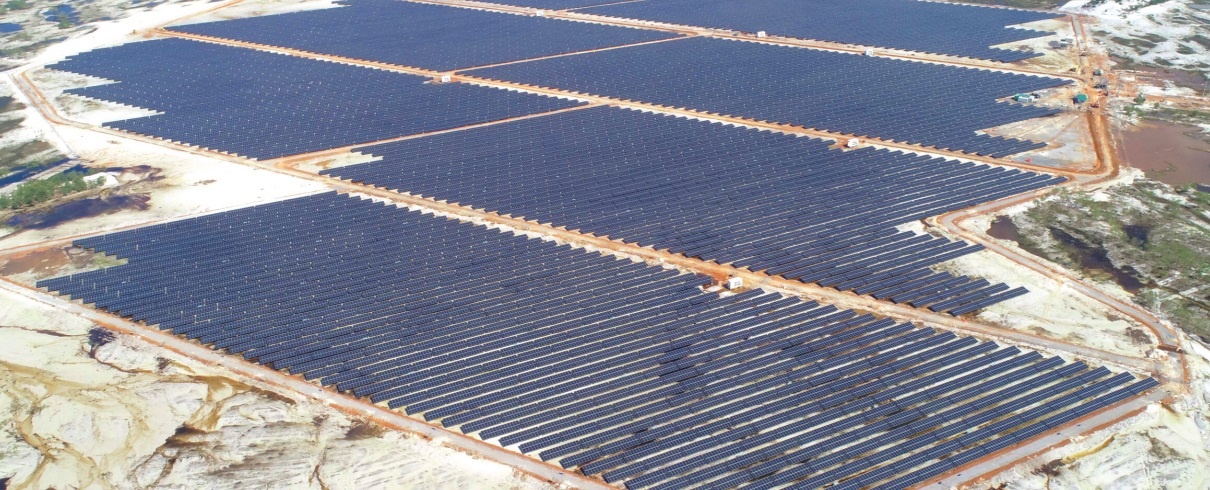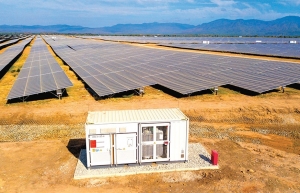Renewables conundrum still up in air
 |
| There are plenty of huge projects trying to take off this decade, but some of the processes are not simple, Photo: Le Toan |
Last week, Quang Tri Department of Planning and Investment said that it had sent a document to the local People’s Committee seeking opinions on the proposal of two foreign companies to contribute capital to two solar power projects in the central province.
The companies, Taiwan’s Shinfox Energy and Singapore’s Camellia Energy, want to invest $5.2 million each in Gio Thanh Energy JSC, the investor of Gio Thanh 1 solar power plant, accounting for 35 per cent of the charter capital. This would mean that foreign companies would account for 70 per cent of Gio Thanh Energy’s charter capital if the proposal is approved.
In December, Sembcorp Solar Vietnam proposed to contribute capital and purchase shares of five projects in the same province. The company is willing to spend $29 million to take over Huong Phung Wind Power Company, the owner of the Huong Phung 2/3 plants, and buy out Gelex Quang Tri Energy Company, which owns Gelex 1-3 plants, for nearly $52 million.
The previous month, Khe Sanh Wind Power JSC, the investor behind the Amaccao Quang Tri 1 wind farm project, also proposed to transfer a 50 per cent stake to a Chinese investor.
A merger and acquisition broker in the renewable energy field told VIR, “Many investors are keen on buying clean energy projects with a clear feed-in tariff (FiT). They are willing to pay over $2 million per megawatt for wind power projects in operation which enjoy the announced FiT scheme. Meanwhile, investors can spend around the same to buy projects with documents, despite not taking advantage of an FiT.”
Many wind power initiatives are racing to sell electricity by the end of 2025 to enjoy an attractive FiT of 6.95 US cents/kWh, signalling that billions of US dollars are awaiting to flow into the renewable energy sector. However, investors are still waiting for new developments of the direct power purchase agreement (DPPA) mechanism.
The Ministry of Industry and Trade (MoIT) noted that of the 95 wind power and solar power projects with a capacity of 30MW or more, 24 projects with a combined capacity of 1,770MW have expressed interest in participating in a pilot scheme for a DPPA in Vietnam. An additional 17 projects, totalling 2,830MW, are considering their eligibility and capability to secure contracts with large electricity consumers.
However, 26 projects have opted out of the DPPA pilot. The MoIT is accelerating the development of the DPPA mechanism to woo investment in renewable energy.
Last month, Copenhagen Infrastructure Partners announced the launch of its Growth Markets Fund II, with a target size of $3 billion. This will enable more than 10GW of new renewable energy capacity.
Vietnam is one of the key focus markets for the fund, with a pipeline of renewable energy projects such as the La Gan offshore wind project, set to be completed in 2030 off the coast of Binh Thuan province.
In addition, Enterprize Energy has been present in Vietnam for the past 4-5 years to seek opportunities to develop offshore wind power. Among them, the group is investing in the Thang Long offshore wind project. It comprises Thang Long Wind with a capacity of 3,400MW and investment of $11.9 billion, and Thang Long Wind 2 with 2,000MW capacity and costing $5 billion.
Likewise, Sembcorp Utilities (SCU) and PetroVietnam Technical Services Corporation are jointly exploring the development of offshore wind farms in Vietnam for the export of electricity to Singapore. Last October, Singapore’s energy regulator granted conditional approval to SCU to import 1.2GW of low carbon electricity from Vietnam to Singapore.
However, there are numerous barriers for offshore wind power projects like these to take off. According to Ernst & Young Vietnam, there are around 20 different risks for developers and lenders involved in offshore wind power project development in Vietnam. They include risks associated with legal permits and approvals, site selection, wind resources, technical design, financing, construction risk, and many more.
The MoIT believes that offshore wind power projects need to be included in the list of important national projects with special policy mechanism. Meanwhile, the ministry also wants a resolution issued to remove legal obstacles for offshore wind power projects in alignment with the Power Development Plan VIII.
Meanwhile, after three years of negotiation, PetroVietnam Power Corporation (PV Power) is making progress on the PPA for the Nhon Trach 3&4 liquefied natural gas (LNG) power plants. However, PV Power faces hurdles with the negotiations on electricity prices and annual power offtake commitments.
In late December, Vietnam Electricity (EVN) completed the price frame for the LNG gas power projects and sent it to the MoIT’s Electricity Regulatory Authority for consideration. This price frame will have to be updated in 2024.
Previously, PV Power proposed 80-90 per cent of annual power offtake within 15 years from the date of commercial operation. However, the current regulation requests the mobilised contracted volume (MCV) of power plants are between 60 and 100 per cent of average long-term power output. PV Power proposed the MCV to be over 70 per cent. However, PV Power and EVN have not agreed on the long-term MCV power output, so it will be difficult to determine the volume of LNG purchase and capital arrangement.
EVN is now worried about the low load demand in reality. However, it still has to buy electricity at high prices due to commitments under the PPA, which will lead to an increase in its electricity purchase costs.
 | $3 billion fund launched for renewables projects in emerging markets Copenhagen Infrastructure Partners (CIP) announced the launch of the Growth Markets Fund II (GMF) on December 4 during COP28 in Dubai. |
 | Localisation in renewables still lacking in high value Although the localisation rate of renewable energy in Vietnam ranges from 38 to 45 per cent, it primarily consists of in low-value sectors with modest technological complexity. |
What the stars mean:
★ Poor ★ ★ Promising ★★★ Good ★★★★ Very good ★★★★★ Exceptional
Related Contents
Latest News
More News
- Driving double-digit growth through green and circular transformation in Vietnam (December 17, 2025 | 09:00)
- Standard Chartered and ACCA deepen collaboration to develop Vietnam’s talent for a sustainable future (December 15, 2025 | 18:18)
- Schaeffler reports strong early output from Dong Nai solar project (December 12, 2025 | 15:16)
- Forestry conference highlights biodiversity and sustainability goals (December 09, 2025 | 13:35)
- Home Credit honoured among top 10 sustainable companies in trade and services (December 09, 2025 | 12:18)
- SCG and seven member companies honoured in Top 100 Sustainable Businesses 2025 (December 08, 2025 | 09:00)
- Nestlé Vietnam pioneers sustainable development and promotes business connections (December 06, 2025 | 12:09)
- CSI 2025 highlights rise of Vietnam’s green champions (December 06, 2025 | 09:00)
- Acecook Vietnam named among top 100 sustainable businesses (December 06, 2025 | 08:00)
- Vietnam’s forest carbon credits draw global interest (December 05, 2025 | 17:41)

 Tag:
Tag:





















 Mobile Version
Mobile Version